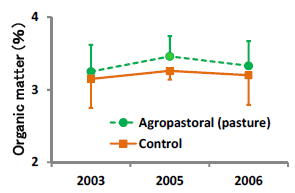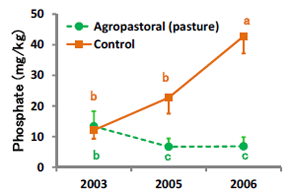Validation and characteristics of long interval rotation of the agropastoral system
Description
In the subtropical savanna of South America, vast areas of cerrados have been cultivated since the 1970s. However, the deterioration of crop productivity in these fields due to continuous cropping poses a dilemma. In addition, as an international commodity crop, the price fluctuation of soybean is huge and acts as a destabilizing factor in management.
The project improved local soybean productivity by introducing an agropastoral system. Moreover, farm operation was stabilized by introducing livestock with lesser price fluctuation in the markets. Hence, the introduction of an agropastoral system was aimed at providing solutions to these problems, and it has been achieving results. Then, the project conducted a comprehensive evaluation of the agropastoral system undertaken in Paraguay by evaluating the concentration of dissolved chemical components of fertilizers at the soil surfaces and organic matter accumulation, and by clarifying the characteristics of an “agropastoral system”.
In Experiment 1, which had a 7-year rotation or conversion interval from pasture back to soybean cultivation, the soybean yield in the agropastoral field was 2.35 times higher than that of the control field (Table 1). In Experiment 2, which had a 4-year interval before being converted back to soybean cultivation from pasture, the soybean yield from the agropastoral field was 1.03 times higher than that of the control field. The former (Exp. 1) exhibited higher benefits than the latter (Exp. 2). Therefore, soybean productivity is boosted if the rotation interval in converting back to soybean field from grazing pasture is longer.
An extensive grazing system experiment in which Zebu cattle were grazed at low density from one to two months in dry season without artificial feeding was conducted in the test pasture of Experiment 1. The intensive grazing system in which cattle were grazed at high density throughout all seasons and fed soybean and hay in dry season was conducted in the pasture of Experiment 2. The former has recovered better than the latter (Table 1).
Shorter grazing period and intensive grazing lower the beneficial effect on soybean production, because they inhibit organic matter accumulation and soil condition does not improve (Fig. 1). However, since dissolution of the phosphates which have accumulated on the soil surface progresses even if the conversion interval is shortened, livestock’s positive effect on soybean productivity is possible (Fig. 2). This is because the large difference in the concentration of phosphates between the soil surface and deep layers inhibits the deeper penetration and growth of soybean roots on the soil thus soybean is not so negatively affected during drought (Table 1).
In South America, where conversion to agropastoral system is spreading, the results of this experiment will serve as reference to soybean farmers who need to choose a suitable soybean system. Since crop yields and prices of soybean fluctuate a lot, it is difficult to obtain comparison of the profits between those of soybean farmers and agropastoral farmers. However, in the intensive grazing system which was conducted in Experiment 2, when the soybean market price did not soar enough (at 20US$/60kg in 2004) and drought happened, livestock was able to compensate for the inadequate profit of soybean cultivation. Therefore, the introduction of the agropastoral system led to the stabilization of farm operation.
Figure, table
-
Table 1. Study site profile, soybean production and soil chemical properties at soil surface (0-10 cm in depth)
-
Fig. 1. Changes in percentage of organic matter contents (%) in the soil surface (At a depth of 0-10 cm) of Experiment 2. -
Fig 2. Changes in phosphate concentration (mg/kg) of Experiment 2 in the soil surface (At a depth of 0-10cm); Different letters indicate significant difference.
- Affiliation
-
Japan International Research Center for Agricultural Sciences Animal Production and Grassland Division
- Classification
-
Research B
- Term of research
-
FY2004~2008
- Responsible researcher
-
SHIMODA Katsuhisa ( Animal Production and Grassland Division )
HORITA Toshiyuki ( Nikkei-CETAPAR )
- ほか
- Publication, etc.
-
- Japanese PDF



